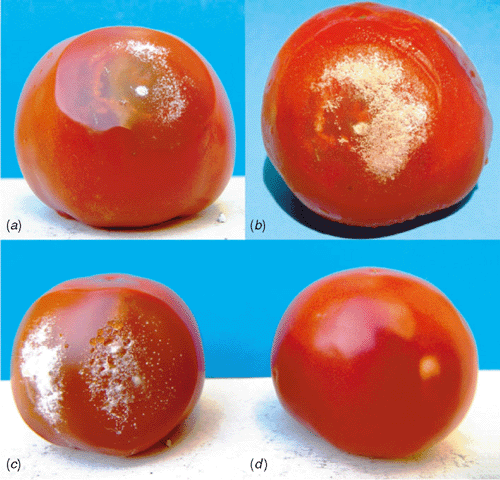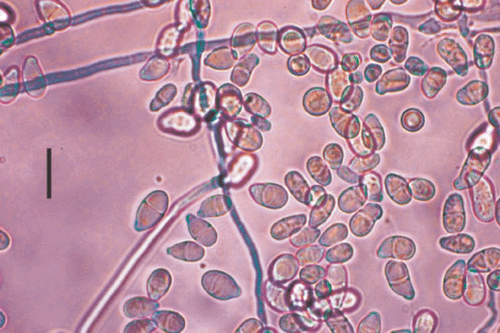First report of Trichothecium roseum causing postharvest fruit rot of tomato in Argentina
G. Dal BelloCentro de Investigaciones de Fitopatología, Facultad de Ciencias Agrarias y Forestales, UNLP, Comisión de Investigaciones Científicas de la Provincia de Buenos Aires, 60 y 119, La Plata 1900, Buenos Aires, Argentina. Email: dalbello@speedy.com.ar
Australasian Plant Disease Notes 3(1) 103-104 https://doi.org/10.1071/DN08041
Submitted: 20 April 2008 Accepted: 8 July 2008 Published: 18 July 2008
Abstract
Postharvest fruit rot caused by Trichothecium roseum on tomato fruit is recorded for the first time in Argentina. The fungus was consistently isolated from diseased fruits and shown to be the causal agent according to Koch’s Postulates. Although the economic impact of the disease is minimal, T. roseum is known as a producer of mycotoxins. Therefore, its presence on vegetables and fruits decreases the quality of those food products and causes a risk to the consumers.
The presence of microorganisms is one of the most important factors in the depreciation in quality of fresh fruits. Commercial value of fruit decreases due to different pathogens, especially fungi, which manifest their destructive action during storage (Puia et al. 2003). Furthermore, contamination of foodstuffs with moulds such as Trichothecium spp. causes a real risk to the health of consumers because these fungi are producers of mycotoxins (Lugauskas et al. 2005). In particular, tomatoes are susceptible to numerous fruit decays, from the field through postharvest handling.
During the summer of 2008, postharvest fruit rot was found on fresh-market tomatoes (Lycopersicon esculentum Mill.) at storage facilities in La Plata city (34°55′S; 57°57′W). Symptoms started as circular, water-soaked lesions, which enlarged and coalesced into a soft rot covered with white to pinkish powdery mycelium (Fig. 1). The fruit became watery and emitted a sour smell. The pathogen was readily isolated by transferring conidia from diseased tissue onto potato dextrose agar (PDA) amended with 250 mg/L of chloramphenicol. Isolates were incubated with a 12/12 h light/dark cycle using cool white fluorescent and near ultraviolet light, at a temperature of 20 ± 2°C for 7 days. After 4–5 days, the fungus produced abundant septate mycelia, white at first, then pale rosy pink as the conidia developed; conidiophores long, slender, simple and septate with conidia which were borne apically and singly, attached in groups or chains; conidia hyaline or brightly coloured, 2-celled, ovoid, 12–22 × 5–10 µm (Fig. 2), appearing in basipetal succession from the tip of the conidiophore. Based on the morphological structures after single-conidium cultures were established on PDA, the causal agent was identified as Trichothecium roseum (Pers.) Link (Howard et al. 1994).

|

|
Pathogenicity was tested by inoculating surface-sterilised healthy, ripe tomato fruits with a 20 µL drop of aqueous conidial suspension (105 conidia/mL) which was injected to a depth of ~1 mm. Fruits inoculated in the same way using sterilised water were kept as a control. Inoculated fruit were placed in a sterilised plastic container at room temperature (21–25°C). Spots similar to those observed on naturally infected fruits developed on inoculated tomatoes within 5 days; whereas control fruits remained healthy (Fig. 1c). Trichothecium roseum was successfully reisolated from the lesions, fulfilling Koch’s Postulates.
The fungus has been cited causing fruit rot on many crops including tomato (Welch et al. 1975; Farr et al. 2007). To our knowledge, this is the first report of T. roseum causing pink mould rot on tomato in Argentina.
Lugauskas A,
Raudonienè V, Šveistytè L
(2005) Toxin producing micromycetes on imported products of plant origin. Annals of Agricultural and Environmental Medicine 12, 109–118.
| PubMed |

Puia CE,
Popovici EJ, Viorel F
(2003) The evolution of the fitosanitary status of the stored apples in natural conditions. Journal of Central European Agriculture [Verified 10 July 2008] 4(4),

Welch AW,
Jenkins SF, Averre CW
(1975) Trichothecium fruit rot on greenhouse tomatoes in North Carolina. Plant Disease Reporter 59, 255–257.



